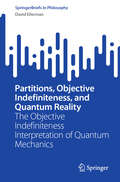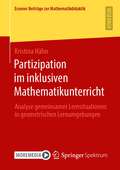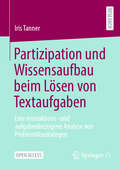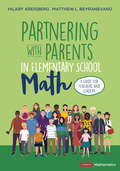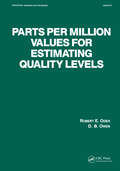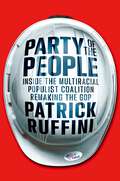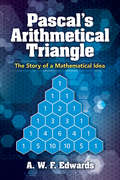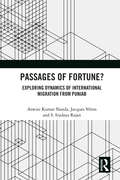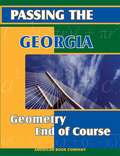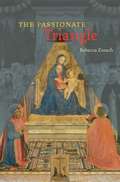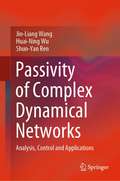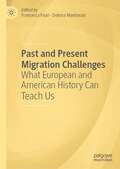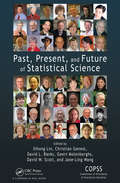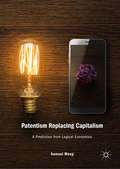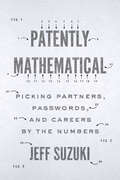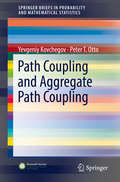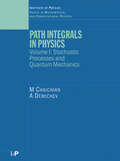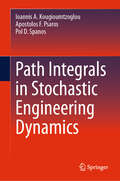- Table View
- List View
Partitions, Objective Indefiniteness, and Quantum Reality: The Objective Indefiniteness Interpretation of Quantum Mechanics (SpringerBriefs in Philosophy)
by David EllermanThis book presents a new ‘partitional' approach to understanding or interpreting the math of standard quantum mechanics (QM). The thesis is that the mathematics (not the physics) of QM is the Hilbert space version of the math of partitions on a set and, conversely, the math of partitions is a skeletonized set level version of the math of QM. Since at the set level, partitions are the mathematical tool to represent distinctions and indistinctions (or definiteness and indefiniteness), this approach shows how to interpret the key non-classical QM notion of superposition in terms of (objective) indefiniteness between definite alternatives (as opposed to seeing it as the sum of ‘waves'). Thus, the book develops a new mathematical, or indeed, logical, approach to the century-old problem of interpreting quantum mechanics, ensure it is of interest to philosophers of science as well as mathematicians and physicists.
Partizipation im inklusiven Mathematikunterricht: Analyse gemeinsamer Lernsituationen in geometrischen Lernumgebungen (Essener Beiträge zur Mathematikdidaktik)
by Kristina HähnKristina Hähn untersucht Verläufe gemeinsamer Lernsituationen im inklusiven Mathematikunterricht und damit verbundene individuelle Partizipationsprozesse von Schülerinnen und Schülern mit dem sonderpädagogischen Unterstützungsbedarf im Lernen. Das gemeinsame Lernen an einem gemeinsamen Gegenstand wird durch Lernumgebungen zum Thema ‚Kreis‘ herausgefordert, die im Sinne des Prinzips der natürlichen Differenzierung entwickelt wurden. Die Ergebnisse der Untersuchung stützen theoretische Überlegungen zum Mehrwert einer Vielfalt gemeinsamer Lernsituationen im inklusiven Unterricht. Darüber hinaus führen sie zu Folgerungen für die Konzeption und den Einsatz substanzieller Lernumgebungen mit dem Ziel, die produktive Beteiligung aller Lernenden am inklusiven Mathematikunterricht zu erhöhen und Partizipationsbarrieren abzubauen.
Partizipation und Wissensaufbau beim Lösen von Textaufgaben: Eine interaktions- und aufgabenbezogene Analyse von Problemlösedialogen
by Iris TannerDas vorliegende Open-Access-Buch geht von der Prämisse aus, dass Lernen aus kognitiver und sozial-konstruktivistischer Sicht als individueller Aufbau von Wissens- und Denkstrukturen verstanden wird. Die Aufgabe der Lehrpersonen besteht dabei darin, mittels ko-konstruktiver Dialoge die Lernenden beim Aufbau und bei der Modifizierung ihrer Wissensstrukturen zu unterstützen. Die vorliegende Studie beschäftigt sich mit der interaktions- und aufgabenbezogenen Analyse von 38 Problemlösedialogen von je vier Lernenden auf der Sekundarstufe I, die in einem tutoriellen Setting eine Aufgabe gemeinsam lösen. Das Unterstützungsverhalten der Lehrpersonen beim Lösen einer mathematischen Textaufgabe und die Partizipation der Lernenden werden ganzheitlich-deskriptiv und in ihrem mikrostrukturellen Ablauf prozessbezogen untersucht. Wie gehen die Lehrpersonen konkret vor, um ihre Schüler und Schülerinnen im Verstehensprozess adaptiv anzuleiten? Gelingt es ihnen, dass die Lernenden an den Problemlösegesprächen entscheidend partizipieren können? Die Ergebnisse zeigen anhand von Fallanalysen auf, wie das auf unterschiedliche Arten gelingen kann.
Partnering With Parents in Elementary School Math: A Guide for Teachers and Leaders (Corwin Mathematics Series)
by Hilary L. Kreisberg Matthew L. BeyranevandHow to build productive relationships in math education I wasn’t taught this way. I can’t help my child! These are common refrains from today’s parents and guardians, who are often overwhelmed, confused, worried, and frustrated about how to best support their children with what they see as the "new math." The problem has been compounded by the shift to more distance learning in response to a global pandemic. Partnering With Parents in Elementary School Math provides educators with long overdue guidance on how to productively partner and communicate with families about their children’s mathematics learning. It includes reproducible surveys, letters, and planning documents that can be used to improve the home-school relationship, which in turn helps students, parents, teachers, and education leaders alike. Readers will find guidance on how to: · Understand and empathize with what fuels parents’ anxieties and concerns · Align as a school and set parents’ expectations about what math instruction their children will experience and how it will help them · Communicate clearly and productively with parents about their students’ progress, strengths, and needs in math · Run informative and fun family events · support homework · Coach parents to portray a productive disposition about math in front of their children Educators, families, and students are best served when proactive, productive, and healthy relationships have been developed with each other and with the realities of today′s math education. This guide shows how these relationships can be built.
Partnering With Parents in Elementary School Math: A Guide for Teachers and Leaders (Corwin Mathematics Series)
by Hilary L. Kreisberg Matthew L. BeyranevandHow to build productive relationships in math education I wasn’t taught this way. I can’t help my child! These are common refrains from today’s parents and guardians, who are often overwhelmed, confused, worried, and frustrated about how to best support their children with what they see as the "new math." The problem has been compounded by the shift to more distance learning in response to a global pandemic. Partnering With Parents in Elementary School Math provides educators with long overdue guidance on how to productively partner and communicate with families about their children’s mathematics learning. It includes reproducible surveys, letters, and planning documents that can be used to improve the home-school relationship, which in turn helps students, parents, teachers, and education leaders alike. Readers will find guidance on how to: · Understand and empathize with what fuels parents’ anxieties and concerns · Align as a school and set parents’ expectations about what math instruction their children will experience and how it will help them · Communicate clearly and productively with parents about their students’ progress, strengths, and needs in math · Run informative and fun family events · support homework · Coach parents to portray a productive disposition about math in front of their children Educators, families, and students are best served when proactive, productive, and healthy relationships have been developed with each other and with the realities of today′s math education. This guide shows how these relationships can be built.
Parts per Million Values for Estimating Quality Levels (Statistics: A Series of Textbooks and Monographs)
by R. E. OdehThis book is an extension of some tables from Odeh and Owen, Volume 32 of the Marcel Dekker, Inc., series Statistics: Textbooks and Monographs. The need for these tables was pointed out to us by Dr. James M. Maynard, who worked with the Parts Per Million Subcommittee.
Party of the People: Inside the Multiracial Populist Coalition Remaking the GOP
by Patrick RuffiniAn eye-opening, &“must-read&” (Ben Shapiro, founder of The Daily Wire) about the future of the Republican party as they unite working-class voters in a multi-racial, cross-generational populist coalition.Donald Trump&’s victory in the 2016 presidential election shocked the world. Yet his defeat in 2020 may have been even more surprising: he received 12 million more votes in 2020 than in 2016 and his unexpectedly diverse coalition included millions of nonwhite voters, a rarity for the modern Republican party. In 2020, Trump defied expectations and few journalists, strategists, or politicians could explain why Trump had nearly won reelection. Patrick Ruffini, a Republican pollster and one of the country&’s leading experts on political targeting, technology, and demography, has the answers—and the explanation may surprise you. For all his apparent divisiveness, Trump assembled the most diverse Republican presidential coalition in history and rode political trends that will prove significant for decades to come. The shift is profound: seven in ten American voters belong to groups that have shifted right in the last two presidential elections, while under three in ten whites with a college degree belong to votes groups that are trending left. Together, this super-majority of right-trending voters forms a colorblind, populist coalition, largely united by its working-class roots, moderate to conservative views on policy, strong religious beliefs, and indifference to or outright rejection of the identity politics practice by the left. Not all these voters are Republican, and in certain corners of the coalition, only a small minority are. But recent elections are pointing us towards a future where party allegiances have been utterly upended. The Party of the People demonstrates this data. Ruffini was as wrong as every pollster in 2016 and spent the intervening years figuring out why and developing better methods of analyzing voters in the digital age. Using robust data, he shifts you away from the complacent, widespread narrative that the Republican party is a party of white, rural voters. It is, but more importantly for its longevity, it&’s a party of non-college-educated voters. And as fewer voters attend college, the Republican party shows no signs of stagnation. With rich data and clear analysis, Party of the People is a &“deeply researched book&” (Amy Walter, editor-in-chief of The Cook Political Report) that explains the present and future of the Republican party and American elections.
Pascal's Arithmetical Triangle: The Story of a Mathematical Idea (Dover Books on Mathematics)
by A.W.F. EdwardsThis survey explores the history of the arithmetical triangle, from its roots in Pythagorean arithmetic, Hindu combinatorics, and Arabic algebra to its influence on Newton and Leibniz as well as modern-day mathematicians.
Passages of Fortune?: Exploring Dynamics of International Migration from Punjab
by Aswini Kumar Nanda Jacques Véron S. Irudaya RajanThis book examines international out-migration from North India, focusing on the state of Punjab. It is the first-ever empirical exploration of the causes, processes, patterns and consequences of international out-migration based on a robust sample of 10,000 households drawn from both rural and urban areas. The volume explores a range of issues such as current migration, return migration, remittances, reverse remittances, diaspora philanthropy, migration consultancy services, international marriages, campaigns for safe migration abroad and plans for emigration in future. It also addresses questions surrounding the use of paid labour by households to replace the work done by the emigrants and studies villages as the migration setting. Additionally, the book organically links to a well-spread-out and vibrant Punjabi diaspora, as well as providing viable baseline data on a range of indicators. A key text on migration studies, this volume will be of great interest to scholars and researchers of development studies, economics, demography, sociology, social anthropology and diaspora studies.
Passing the Georgia Geometry End of Course Test
by Erica Day Alan Fuqua Colleen PintozziPassing the Georgia Geometry End of Course Test will help you review and learn important concepts and skills related to high school mathematics. To help identify which areas are of great-est challenge for you, first take the diagnostic test, then complete the evaluation chart with your instructor in order to help you identify the chapters which require your careful attention.
The Passionate Triangle
by Rebecca ZorachTriangles abounded in the intellectual culture of early modern Europe—the Christian Trinity was often mapped as a triangle, for instance, and perspective, a characteristic artistic technique, is based on a triangular theory of vision. Renaissance artists, for their part, often used shapes and lines to arrange figures into a triangle on the surface of a painting—a practice modern scholars call triangular composition. But is there secret meaning in the triangular arrangements artists used, or just a pleasing symmetry? What do triangles really tell us about the European Renaissance and its most beguiling works of art? In this book, Rebecca Zorach takes us on a lively hunt for the triangle’s embedded significance. From the leisure pursuits of Egyptian priests to Jacopo Tintoretto’s love triangles, Zorach explores how the visual and mathematical properties of triangles allowed them to express new ideas and to inspire surprisingly intense passions. Examining prints and paintings as well as literary, scientific, and philosophical texts, The Passionate Triangle opens up an array of new ideas, presenting unexpected stories of the irrational, passionate, melancholic, and often erotic potential of mathematical thinking before the Scientific Revolution.
Passivity of Complex Dynamical Networks: Analysis, Control and Applications
by Jin-Liang Wang Huai-Ning Wu Shun-Yan RenThis book intends to introduce some recent results on passivity of complex dynamical networks with single weight and multiple weights. The book collects novel research ideas and some definitions in complex dynamical networks, such as passivity, output strict passivity, input strict passivity, finite-time passivity, and multiple weights. Furthermore, the research results previously published in many flagship journals are methodically edited and presented in a unified form. The book is likely to be of interest to university researchers and graduate students in Engineering and Mathematics who wish to study the passivity of complex dynamical networks.
Passport to Algebra and Geometry
by Roland E. LarsonTextbook showing the foundations of algebra and geometry
Passport to Algebra and Geometry, with Assessment Handbook
by Ron Larson Laurie Boswell Timothy D. Kanold Lee StiffNumber theory, rational numbers and percents, real numbers and inequalities, linear equations, congruence, similarity, and transformations are some of the topics covered. Real life applications and uses of the math that students are being asked to learn continues to be incorporated in the text and exercises.
Passport to Mathematics, Book 2
by Ron Larson Laurie Boswell Timothy D. Kanold Lee StiffThis book is preparing students for success in mathematics in the middle grades and beyond. In this course students will study important middle grade mathematics concepts and see how they are related and also find a gradual approach to understanding the underlying principles of algebra and geometry.
Past and Present Migration Challenges: What European and American History Can Teach Us
by Francesca Fauri Debora MantovaniThis edited collection sheds light on the complex nature of migratory movements through the lens of economic and social history. It addresses a variety of migration issues involving Europe and the Americas in order to offer new insights on past and future migration and integration policies. The volume comprises multi-disciplinary research from both continents dealing with the economic, political, demographical and sociological impact of migration. This interdisciplinary approach aims to stimulate intellectual dialogue on the migration phenomenon among the international community of scholars in Europe and North and South America. It is divided into three parts, which offer an essential contribution to the issue of migration and aim at better understanding the effect that different forms of migration have had and will continue to exert on economic and social change in receiving countries. This book is a valuable resource for a wide audience including academics, students in the economic and social sciences, and government and EU officials working with migration topics.
Past, Present, and Future of Statistical Science
by Xihong Lin Christian Genest David L. Banks Geert Molenberghs David W. Scott Jane-Ling WangPast, Present, and Future of Statistical Science was commissioned in 2013 by the Committee of Presidents of Statistical Societies (COPSS) to celebrate its 50th anniversary and the International Year of Statistics. COPSS consists of five charter member statistical societies in North America and is best known for sponsoring prestigious awards in stat
Patentism Replacing Capitalism: A Prediction from Logical Economics
by Samuel MengBased on economic knowledge and logical reasoning, this book proposes a solution to economic recessions and offers a route for societal change to end capitalism. The author starts with a brief review of the history of economics, and then questions and rejects the trend of recent decades that has seen econometrics replace economic theory. By reviewing the different schools of economic thought and by examining the limitations of existing theories to business cycles and economic growth, the author forms a new theory to explain cyclic economic growth. According to this theory, economic recessions result from innovation scarcity, which in turn results from the flawed design of the patent system. The author suggests a new design for the patent system and envisions that the new design would bring about large economic and societal changes. Under this new patent system, the synergy of the patent and capital markets would ensure that economic recessions could be avoided and that the economy would grow at the highest speed.
Patently Mathematical: Picking Partners, Passwords, and Careers by the Numbers
by Jeff SuzukiUncovers the surprising ways math shapes our lives—from whom we date to what we learn.How do dating sites match compatible partners? What do cell phones and sea coasts have in common? And why do computer scientists keep ant colonies? Jeff Suzuki answers these questions and more in Patently Mathematical, which explores the mathematics behind some of the key inventions that have changed our world.In recent years, patents based on mathematics have been issued by the thousands—from search engines and image recognition technology to educational software and LEGO designs. Suzuki delves into the details of cutting-edge devices, programs, and products to show how even the simplest mathematical principles can be turned into patentable ideas worth billions of dollars. Readers will discover • whether secure credit cards are really secure• how improved data compression made streaming video services like Netflix a hit• the mathematics behind self-correcting golf balls• why Google is such an effective and popular search engine• how eHarmony and Match.com find the perfect partner for those seeking a mate• and much more!A gifted writer who combines quirky historical anecdotes with relatable, everyday examples, Suzuki makes math interesting for everyone who likes to ponder the world of numerical relationships. Praise for Jeff Suzuki's Constitutional Calculus"Presents an entertaining and insightful approach to the mathematics that underlies the American system of government. The book is neatly organized, breaking down the United States Constitution by article, section, and amendment. Within each piece, Suzuki reviews the mathematical principles that went into the underlying framework."—Mathematical Reviews"A breath of fresh air.... A reaffirmation that mathematics should be used more often to make general public policy."—MAA Reviews
Patently Mathematical: Picking Partners, Passwords, and Careers by the Numbers
by Jeff SuzukiFascinating facts and stories behind inventions based on mathematics—from search engines to streaming video to self-correcting golf balls. How do dating sites match compatible partners? What do cell phones and sea coasts have in common? And why do computer scientists keep ant colonies? Jeff Suzuki answers these questions and more in Patently Mathematical, which explores the mathematics behind some of the key inventions that have changed our world.In recent years, patents based on mathematics have been issued by the thousands—from search engines and image recognition technology to educational software and LEGO designs. Suzuki delves into the details of cutting-edge devices, programs, and products to show how even the simplest mathematical principles can be turned into patentable ideas worth billions of dollars. Discover:• whether secure credit cards are really secure• how improved data compression made streaming video services like Netflix a hit• the mathematics behind self-correcting golf balls• why Google is such an effective and popular search engine• how eHarmony and Match.com bring couples together, and much moreCombining quirky historical anecdotes with relatable everyday examples, Suzuki makes math interesting for everyone who likes to ponder the world of numerical relationships.Praise for Jeff Suzuki’s Constitutional Calculus“An entertaining and insightful approach to the mathematics that underlies the American system of government.” —Mathematical Reviews“A breath of fresh air. . . . A reaffirmation that mathematics should be used more often to make general public policy.” —MAA Reviews
Path Coupling and Aggregate Path Coupling (SpringerBriefs in Probability and Mathematical Statistics)
by Yevgeniy Kovchegov Peter T. OttoThis book describes and characterizes an extension to the classical path coupling method applied to statistical mechanical models, referred to as aggregate path coupling. In conjunction with large deviations estimates, the aggregate path coupling method is used to prove rapid mixing of Glauber dynamics for a large class of statistical mechanical models, including models that exhibit discontinuous phase transitions which have traditionally been more difficult to analyze rigorously. The book shows how the parameter regions for rapid mixing for several classes of statistical mechanical models are derived using the aggregate path coupling method.
Path Integrals and Hamiltonians
by Belal E. BaaquieThis book applies the mathematics and concepts of quantum mechanics and quantum field theory to the modelling of interest rates and the theory of options. Particular emphasis is placed on path integrals and Hamiltonians. Financial mathematics is currently almost completely dominated by stochastic calculus. The present book is unique in that it offers a formulation that is completely independent of that approach. As such many new results emerge from the ideas developed by the author. This pioneering work will be of interest to physicists and mathematicians working in the field of finance, to quantitative analysts in banks and finance firms and to practitioners in the field of fixed income securities and foreign exchange. The book can also be used as a graduate text for courses in financial physics and financial mathematics.
Path Integrals in Physics: Volume I Stochastic Processes and Quantum Mechanics
by M Chaichian A DemichevPath Integrals in Physics: Volume I, Stochastic Processes and Quantum Mechanics presents the fundamentals of path integrals, both the Wiener and Feynman type, and their many applications in physics. Accessible to a broad community of theoretical physicists, the book deals with systems possessing a infinite number of degrees in freedom. It discusses the general physical background and concepts of the path integral approach used, followed by a detailed presentation of the most typical and important applications as well as problems with either their solutions or hints how to solve them. It describes in detail various applications, including systems with Grassmann variables. Each chapter is self-contained and can be considered as an independent textbook. The book provides a comprehensive, detailed, and systematic account of the subject suitable for both students and experienced researchers.
Path Integrals in Stochastic Engineering Dynamics
by Ioannis A. Kougioumtzoglou Pol D. Spanos Apostolos F. PsarosThis book organizes and explains, in a systematic and pedagogically effective manner, recent advances in path integral solution techniques with applications in stochastic engineering dynamics. It fills a gap in the literature by introducing to the engineering mechanics community, for the first time in the form of a book, the Wiener path integral as a potent uncertainty quantification tool. Since the path integral flourished within the realm of quantum mechanics and theoretical physics applications, most books on the topic have focused on the complex-valued Feynman integral with only few exceptions, which present path integrals from a stochastic processes perspective. Remarkably, there are only few papers, and no books, dedicated to path integral as a solution technique in stochastic engineering dynamics. Summarizing recently developed techniques, this volume is ideal for engineering analysts interested in further establishing path integrals as an alternative potent conceptual and computational vehicle in stochastic engineering dynamics.
